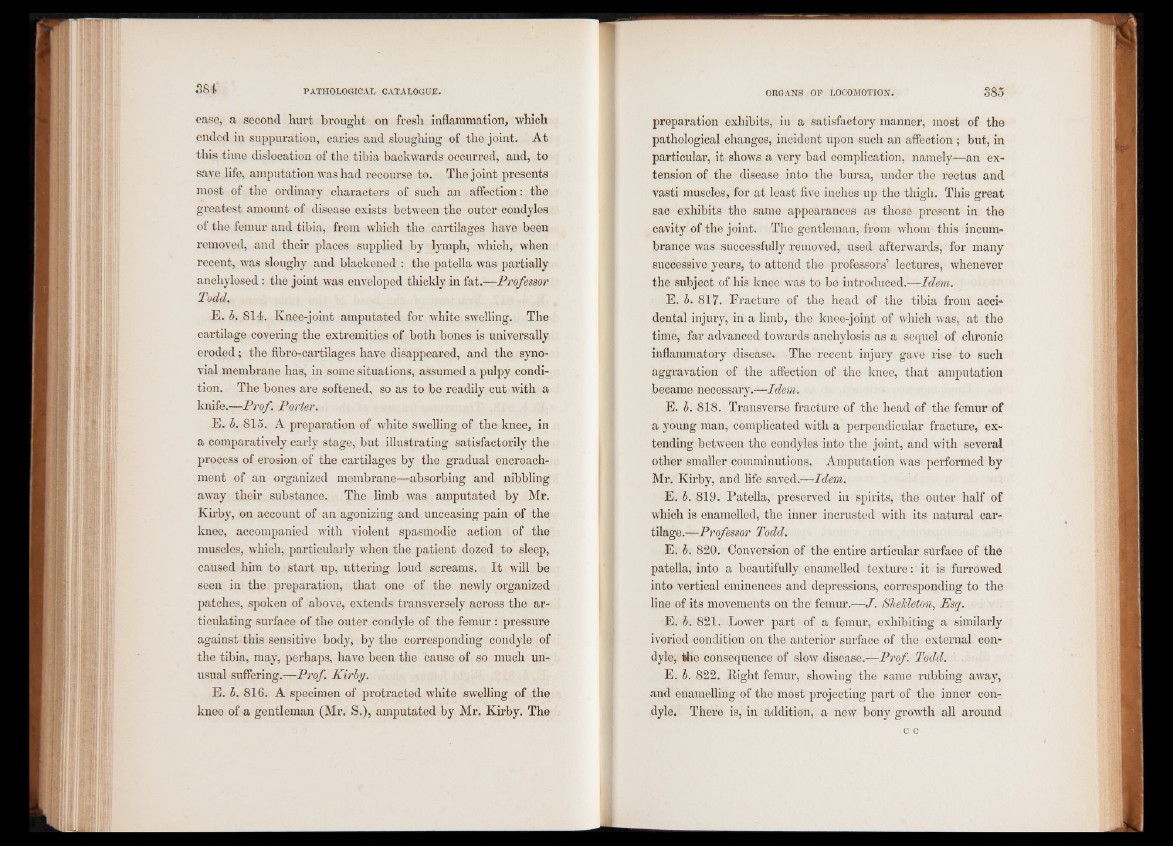
ease, a second hurt brought on fresh inflammation, which
ended in suppuration, caries and sloughing of the joint. At
this time dislocation of the tibia backwards occurred, and, to
save life, amputation was had recourse to. The joint presents
most of the ordinary characters of such an affection: the
greatest amount of disease exists between the outer condyles
of the femur and tibia, from which the cartilages have been
removed, and their places supplied by lymph, which, when
recent, was sloughy and blackened : the patella was partially
anchylosed: the joint was enveloped thickly in fat.—Professor
Todd.
E. b. 814. Knee-joint amputated for white swelling. The
cartilage covering the extremities of both bones is universally
eroded; the fibro-cartilages have disappeared, and the synovial
membrane has, in some situations, assumed a pulpy condition.
The bones are softened, so as to be readily cut with a
knife.—Prof. Porter.
E. b. 815. A preparation of white swelling of the knee, in
a comparatively early stage, but illustrating satisfactorily the
process of erosion of the cartilages by the gradual encroachment
of an organized membrane—absorbing and nibbling
away their substance. The limb was amputated by Mr.
Kirby, on account of an agonizing and unceasing pain of the
knee, accompanied with violent spasmodic action of the
muscles, which, particularly when the patient dozed to sleep,
caused him to start up, uttering loud screams. It will be
seen in the preparation, that one of the newly organized
patches, spoken of above, extends transversely across the articulating
surface of the outer condyle of the femur : pressure
against-this sensitive body, by the corresponding condyle of
the tibia, may, perhaps, have been the cause of so much unusual
suffering.—Prof. Kirby.
E. b. 816. A specimen of protracted white swelling of the
knee of a gentleman (Mr. S.), amputated by Mr. Kirby. The
preparation exhibits, in a satisfactory manner, most of the
pathological changes, incident upon such an affection ; but, in
particular, it shows a very bad complication, namely—an extension
of the disease into the bursa, under the rectus and
vasti muscles, for at least five inches up the thigh. This great
sac exhibits the same appearances as those present in the
cavity of the joint. The gentleman, from whom this incumbrance
was successfully removed, used afterwards, for many
successive years, to attend the professors’ lectures, whenever
the subject of his knee was to be introduced.—Idem.
E. b. 817. Fracture of the head of the tibia from accidental
injury, in a limb, the knee-joint of which wras, at the
time, far advanced towards anchylosis as a sequel of chronic
inflammatory disease. The recent injury gave rise to such
aggravation of the affection of the knee, that amputation
became necessary.—Idem.
E. b. 818. Transverse fracture of the head of the femur of
a young man, complicated with a perpendicular fracture, extending
between the condyles into the joint, and with several
other smaller comminutions. Amputation was performed by
Mr. Kirby, and life saved.—Idem.
E. b. 819. Patella, preserved in spirits, the outer half of
which is enamelled, the inner incrusted with its natural cartilage.—
Professor Todd.
E. b. 820. Conversion of the entire articular surface of the
patella, into a beautifully enamelled texture: it is furrowed
into vertical eminences and depressions, corresponding to the
line of its movements on the femur.—J. SheJcleton, Esq.
E. b. 821. Lower part of a femur, exhibiting a similarly
ivoried condition on the anterior surface of the external condyle,
the consequence of slow disease.—Prof. Todd.
E. b. 822. Right femur, showing the same rubbing away,
and enamelling of the most projecting part of the inner condyle.
There is, in addition, a new bony growth all around